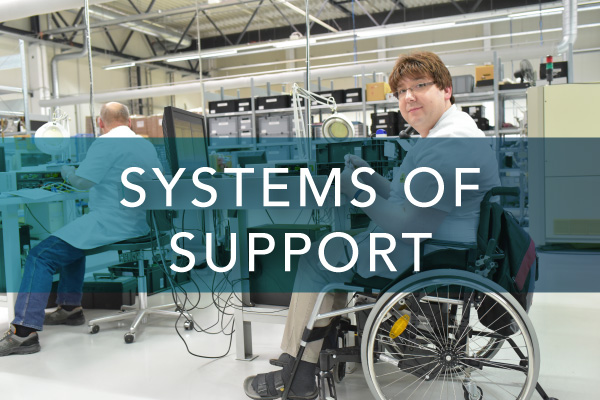Inclusive Employer Toolkit
The Equity Committee of the Workforce Innovation Board of Ramsey County has assembled this action guide to help employers in our community and region improve diversity, equity, and inclusion (DEI). Our purpose in creating this resource is to provide practical tools that will ultimately help move the needle on workforce disparities and provide equitable access to wealth and opportunity.
This guide offers concrete practices to build diverse, equitable, and inclusive workplaces in the areas of staff recruitment, hiring, onboarding, and retention. Much of the information contained in this guide was crowd-sourced from employers and experts committed to achieving equity outcomes.
DEI

Introduction

Introduction
All Minnesotans need opportunities for sustainable employment.
Context:
Our country and region have a history of discrimination and persecution leading to systemic and institutional injustices. These injustices have been endured by a diverse many within our community who identify with various nondominant, under-resourced and underrepresented groups. These are neighbors with diverse abilities, races, sexual orientations, ages, genders, religions, first languages and more.
Black, Indigenous, and racially and ethnically diverse communities have faced adversity disproportionate to their white neighbors through many generations. Consequently, we see disparities in educational attainment, employment, income and wealth. Ramsey County has committed to an Economic Competitiveness and Inclusion Plan, prioritizing inclusion and equity in future investments and other actions related to housing, job creation, workforce development and place-based investments.
It is challenging for employers and workplaces to recognize and address the impacts of discrimination and unconscious bias within their organizations. Actionable and unique strategies are required to meet the needs of diverse communities and employees. Yet, within these challenges lie tremendous opportunities and benefits for job seekers, employers and our community. If all members of our community have access to quality jobs in thriving workplaces that truly represent the diversity of our region, our economy will be stronger. Research has proven that diversity in the workplace creates a workforce that is more innovative and apt to solve problems.
Ramsey County’s unmatched diversity is an asset and opportunity for the region’s growth and prosperity. Ramsey County is the most diverse county in the state with 35.5% of county residents identifying as Black, Indigenous, and racially and ethnically diverse, and an additional 7.5% identifying as Hispanic or Latinx. Additionally, 15.7% of residents are foreign-born and 10.6% speak a language other than English as their predominate language1. The local talent pool will continue to grow more diverse as young people graduate and enter the workforce given that 60.4% of students enrolled in K-12 education in Ramsey County are students of color (54.3% of all school enrollment across Pre-K through graduate school). As our community and workforce grows more diverse, it is imperative and to our advantage that workplaces are welcoming and responsive to these changes regardless of race, ethnicity, age, gender, religion, sexual orientation, gender identity, gender expression, disability, economic status and other diverse backgrounds.
COVID-19 has dramatically shifted the way in which many employers operate, causing workplaces to reconsider and reassess how they work. Regardless of an employer’s sector, size, type, status or whether it’s union or non-union, we have an opportunity to create better systems to recruit, hire, welcome and retain employees more effectively. This toolkit provides concrete best practices that employers of all sizes and across all industry sectors can implement to create a diverse and inclusive workplace.
Advancing Equity
In an effort and commitment to address opportunity gaps affecting Ramsey County’s workforce, we recognize:
- Equity is different from equality. Advancing equity ensures all people who need access to the opportunities and services we provide will receive them.
- Equity also recognizes that varying community members receive supports uniquely needed for them to thrive and prosper.
- The pursuit of workforce equity acknowledges:
- Ramsey County communities and surrounding area were established on Indigenous land.
- The historical conditions and structural and institutional barriers that have withheld opportunity and success for community members based on their race, gender or perceived gender, ability, sexual orientation, age, incomes and other social conditions.
- Eliminating those structural and institutional barriers to opportunities requires systemic change that allows for fair distribution of resources, access, information and other support to let people thrive.
The following pages outline several equitable and inclusive best practices. Most are applicable to employers of any size and type, some may be more relevant to larger employers. All employers can benefit from the tools and resources listed here and are encouraged to share additional resources and best practices with each other and with the Workforce Innovation Board of Ramsey County.
[1] 2021 US Census Bureau 5-Year ACS Data accessed 2.23.2023 at: http://data.census.gov/table?t=School+Enrollment&g=0500000US27123

Recruiting

Recruiting
End Result:
To write and disseminate a job posting that reaches a diverse audience and that is inclusive of the spectrum of gender, abilities and non-dominant races and cultures.
Suggested Metrics:
- Gather information about the demographics of those who apply. This information must be kept separate from the application and reviewed only after the hire is made.
- Track demographics of applicants such as gender, race, and geography, as well as source of job referral to monitor impact of recruiting efforts.
Best Practices:
Create Inclusive and Equitable Job Descriptions & Postings
Language and information
- Use language that appeals to everyone.
- Use gender-neutral descriptions (i.e., firefighter vs. fireman).
- Use plain language at a reading level accessible to all candidates.
- Avoid jargon and idioms which can create avoidable language barriers for non-native English speakers and other groups.
- Define the expectations of the job using ADA compliant vocabulary. Include an Equal Employment Opportunity statement.
- Include an Indigenous Land Acknowledgement Statement.
Wages
- Explicitly state wage rates in job postings. Withholding wage/salary ranges in job postings disadvantages women and people of color, who are less likely to succeed in negotiating salary than white male applicants.
Benchmark wage rates using current job descriptions so that pay is based on market value of each role versus what an applicant has been paid in the past. This helps to alleviate the pay-gap inherent in many systems and promotes equal pay for equal work.
Employee Benefits Packages
It's time to think differently about what is offered to employees in the benefit arena. Classic benefits of health care, retirement, vacation, etc. are critical. However, adding innovative benefits that help employees balance and offset costs in their work and home lives and that offer resources for career progression are making employers stand out when it comes to attracting and retaining employees. Consider these ideas, particularly for your entry level or lower wage employees:
- Transportation - provision of transit passes, paid parking, carpool coordination, payment for back-up/emergency rides with ride share companies or taxi.
- Offset household or life expense - this may include gift cards, direct payments and/or scholarships. Employers may use other means of helping with costs that are not included as wages. Consider gift cards for grocery stores or summer camps for employee children, payment to providers for employee’s cell phone or internet, be creative.
- Up front tuition rather than reimbursement – low income households often do not have resources to pay up front for education, credentialing and further training even if they will get reimbursed following the training. Employers may pay the trainer directly to help these employees.
- Financial counseling and education – proactive and dedicated resources for employee’s to learn about managing their finances for short and long term.
- Child and elder care – offer subsidies or payment directly to the providers (also possible tax benefit for employer) and resources for back up care.
Job requirements
- Assess job requirements for true necessity to the job then clearly state the requirements in the job posting and/or job description.
- Common job requirements that may not be necessary: Driver’s license, high school diploma/GED, specific degree or field of study, personal vehicle, physical requirements, etc.
- Consider using the phrase “access to reliable transportation” rather than “access to a personal vehicle.”
- Carefully consider if a college degree is required for the job. Whenever possible, allow years of work/life or military experience in lieu of a college degree.
- State essential and specific physical demands and the frequency expected to fulfill them.
- State whether a drug test, criminal background check, and/or credit check will be conducted as part of the application process.
Applications
- Accept paper applications.
- Provide ways to access applications through publicly accessible computers.
- Have staff available to support job seekers in completing their application.
Best Practices:
Expand Job Posting Locations and Strategy
Sourcing Talent
- Post to reach a maximum audience.
- Broaden your list of where you post jobs to reach a variety of audiences. Leverage local networks, such as:
- Job Connect.
- Eastside Employment xChange.
- LOCUS.
- Vocational Rehabilitation Services.
- Mossier – LGBTIQA+ hiring events.
- College Central Minnesota State.
- Post on Facebook, Instagram, and LinkedIn.
- Post on MinnesotaWorks.
- Host a virtual or in-person hiring event at CareerForce.
- Build relationships with community organizations to cast a wider net.
- Build relationships with community training providers to access recently trained workers.
- Connect with local school district career pathways programs.
- Provide a youth work experience or internship through the Right Track program or one of our youth and young adult programs.
Interviews and other screening
- Set clear criteria to determine which criminal offenses would exclude someone from employment.
- Do not consider arrests - they are not proof of guilt.
- Do not ask about conviction records. If you must, commit to carefully evaluating the relevance of criminal convictions specific for each job.
- Follow recommendations from the Minnesota Employers’ Fair Chance Hiring Guide.
- Create a waiver process that would allow an applicant with a criminal background to request special consideration based on defined factors such as enrollment with a community-based partner organization or completion of a recognized program.
Physical Environment and Marketing
- Highlight your diversity, equity, and inclusion strategies as an introduction to the organization.
- Post a rainbow flag sticker on the front door/window and on the organization’s website to signify a safe space for LGBTQ+ individuals.
- Make sure pictures on your website represent all types of employees to show diversity and inclusion.
- Choose art to hang in the office that represents diverse artists and themes.
- Be thoughtful about whether representations of political positions on the company website and materials support diversity and inclusion.
- Include a cover letter or summary document in postings or employment sites that highlights workplace culture, particularly as it relates to creating a welcoming and inclusive environment.
Tools and resources
- How to attract diverse and qualified candidates - CareerForce.
- Writing accommodating job descriptions.
- Which Benefits Do Employees Really Want? (10+ Companies With the Best Benefits) - Bamboo HR
- 17 Innovative And Trendy Employee Benefits That Actually Work - Forbes
- 31 Unique Employee Benefits that Your Employees Will Love - IncentFit
- Creating an inclusive job posting - CareerForce.
- Federal plain language guide.
- A guide to indigenous land acknowledgement - Native Governance Center.
- Integrate pronouns into your recruiting process - Seen at Work.

Hiring

Hiring
End Result:
To mitigate and prevent unconscious bias in screening, interviewing, and hiring candidates.
Suggested Metrics:
- Once the hiring process is over, review applicant demographics to document the number of candidates who applied and were interviewed from identified groups.
- Track demographics of those interviewed and ultimately hired with improvement goals for the next hiring period.
Best Practices:
Create multiple and accessible career entry points
- Create or identify entry-level positions that have fewer requirements and/or eliminate barriers to entry. Market these positions as an entry point for your organization with a clear map of opportunities for advancement.
- Develop “grow your own” programs that integrate on-the-job training into all positions, especially those at the entry level.
- Create internship positions and ensure adequate training and supervision is provided to create a meaningful experience.
- Build an apprenticeship program to offer earn-while-you-learn job opportunities and ensure a continuous pipeline of skilled workers.
- Consider hybrid employment for roles that do not require 100% in office time.
- Make early connections to future workers by contacting your nearby high schools to build relationships with the Career and Technical Education programs. These programs offer job site tours and connection to real-world experience for youth.
Best Practices:
Pay close attention to the candidate experience.
Interviews and other screening
- Assure the interview team includes diversity and utilizes at least one person from another team, department, or partnering organization.
- Ensure the hiring team has had training on awareness and prevention of implicit bias.
Interview process
- Audit the interview process for potential bias.
- Consider blind hiring techniques. Remove or code the applicant’s name, gender, and address prior to reviewing applications.
- Utilize uniform or standard interviewing methods, including asking the same questions of all candidates.
- Determine whether follow-up questions will be allowed.
- Evaluate responses using a consistent scale or rubric to measure interview performance across all candidates.
- Develop a threshold for permitting grammar and spelling mistakes on resumes/applications, when applicable.
- Include interview questions about the applicant’s experience working with people from diverse backgrounds and examples of demonstrating their commitment to equity/inclusiveness.
- Gather additional qualitative information by allowing interviewers to write comments regarding their applicant scoring.
- Review interview panel comments to assess whether implicit bias may have been a factor in candidate evaluation and follow up with training to avoid in the future.
- Adequately plan for time and ensure enough time is allowed for the candidate to ask questions.
- Schedule 15 minutes between each candidate to allow the interview panel time to fully debrief.
- Allow 15-30 minutes before the interview begins for a candidate to review interview questions, the job description, or a summary of key duties.
- Be prepared to talk about your diversity and inclusion activities, initiatives, and/or goals in the interview.
- If appropriate, include a work or skills test/evaluation as part of the interview process. Inform the candidate that this will occur prior to the interview. Set clear criteria for how this will be scored and its weight in the hiring process.
Interview technology
- Provide candidates with the organization’s remote interview protocol or best practices in advance, addressing camera, microphone, and operating system requirements, backgrounds, whether the chat box will be open, etc.
- Provide alternative methods of conducting virtual interviews if technology fails or if the candidate does not have computer/internet access.
- Whenever possible, include a default phone-in option for virtual interviews.
- Consider in-person alternatives to virtual interviews, such as drive-through application/interview events.
Best Practices:
Be transparent and objective.
Making a hiring decision
- Award points for additional factors such as relevant experience/background, addition of skills currently lacking on the work team, or bringing a unique perspective to the organization.
- Avoid evaluating subjective factors like “good fit” or “professionalism,” or giving a likeability score in the point system.
- Keep records detailing why candidates were or were not selected.
- Allow candidates the opportunity to request information on why they were not selected to advance to the next stage in the process.
- Solicit candidate feedback on their experience with the interview process.
Best Practices:
Skills Based Hiring.
Skills based hiring is a recruitment approach that focuses on evaluating candidates based on their skills, rather than on their education or past work experience. Advantages of Skills Based Hiring include:
- Increased quality of hires by matching applicant skills and competencies to job duties.
- Expanded talent pools and increased talent pipeline diversity by tapping applicants who are often overlooked due to lack of formal education.
- Reduction of bias when skills are objectively measured and matched to roles for each applicant.
- Improved employee retention as skills align with assigned and changing roles.
Tools and resources
- Recognizing hidden bias in recruiting and hiring - CareerForce.
- A guide to inclusive hiring - city of Minneapolis (pg. 4 - “Evaluate Your Current Practice: The Recruiting Cycle”).
- Equitable hiring tool - City of Madison, WI.
- Minnesota employer’s fair chance hiring guide - Twin Cities R!se.
- Can blind hiring improve workplace diversity? – Society of Human Resources Management.
- 7 practical ways to reduce bias in your hiring process - Society of Human Resources Management.
- Free Harvard implicit bias test.
- Ready for success: Adopting a skills mindset in employment practices toolkit – Society of Human Resource Management.
- Skills-based practices – Minnesota Department of Labor and Industry.
- Importance of pronouns and inclusive language in hiring - Clovers.

Onboarding

Onboarding
End Result:
Establish two-way communication with new hires and supervisors. Ensure new hires feel welcomed into an inclusive workplace.
Suggested Metric:
Utilize an onboarding survey after the probation period ends to evaluate effectiveness and identify opportunities for improvement.
- Ask employee to evaluate and rate:
- Satisfaction with each orientation component/module/activity.
- Organizational culture.
- Their level of feeling welcomed.
- Match survey questions to key components of the onboarding plan.
- Consider ways to conduct the survey that will elicit honest feedback without fear of consequences. For example, consider having a neutral third party from Human Resources or another department receive and review responses and generate recommendations.
Best Practices
Onboarding is well-planned, thoroughly communicated and focused on relationship building.
Clear and comprehensive onboarding process/orientation plan.
- Draft a written orientation plan that includes:
- Human resources paperwork.
- Overview of the organization, including review of the organizational chart.
- Building walk-through.
- Face-to-face introduction to key staff.
- One-on-one conversations with peers/primary coworkers integrating training content.
- Connection to other recent hires.
- Eat lunch together at a specific time and location on first day.
- Conduct an open conversation during orientation to share communication and learning styles between leadership and new hires.
- Give everyone the same language for understanding strengths and differences by having everyone on a team or in a department complete the same self-assessment and make this self- assessment part of orientation. Consider:
- Draft a work plan that includes a specific schedule of meetings, tasks and deadlines for the first two to three weeks of work.
For hiring manager/team
- Set clear performance expectations.
- Provide details of the role within the organization and job responsibilities.
- Ensure that the new employee’s workspace is completely set up prior to the first day and that all work-related needs have been assessed and met.
For organization/Human Resources
- Provide a Request for Accommodations Form or a similar protocol prior to the first day and ensure accommodations are in place.
- Prioritize an inclusion program as part of orientation.
- Share an Inclusion Statement before or during the first week of employment.
- Communicate established workplace norms, including ‘unspoken rules.’ Norms often include lunch hour expectations, dress code, tardiness, cell phone usage, perfume use, etc.
- Send new hires individual welcome communications from leadership.
- Encourage personal outreach from colleagues during first week of work.
- Clearly define and share the organization’s approach to conflict management.
- Provide and review information on how to report discrimination or harassment.
Professional growth planning
- Establish a culture of continued learning and professional development from day one.
- Have supervisors and new employees work together to create professional growth plans. Review plans at least once a year to revise and note progress.
- Set aside a budget for professional development with specific guidance on how employees can request support for training.
Tools and resources
- Virtual Onboarding and Cultivation Guide – The New Teacher Project.
- New Employee Onboarding Guide - Society of Human Resource Management.
- Onboarding Tools - Human Resources Today.
- Onboarding Remote Workers - Workable.

Retention

Retention
End Result:
To retain high-quality and diverse staff and to promote diversity into positions of leadership.
Suggested Metrics:
- Conduct an employee satisfaction survey or stay interview to measure qualitative work values like trust, comfort and feeling valued. Have a protocol in place for following up on responses.
- Keep data on retention and set a goal for retention rate.
- Conduct exit interviews with all employees leaving the organization to evaluate areas for improvement.
- Keep data on diversity in leadership roles. Ensure that any data revealing racial disparities is addressed concretely, sufficiently and in a timely manner.
Best Practices:
Strong relationships through mentoring and inclusion.
For hiring manager/team
Relationships and welcoming environment
- Check in and tend to the emotional, personal, and professional needs of coworkers/employees (especially during/after major events).
- Understand and respect that different people will need different kinds of support.
- Humanize the workplace with more meaningful one-on-one and team interactions.
- Create opportunities for relationship building and team building in addition to day-to-day operations.
- Reward and recognize employees who have made positive contributions to the team and organization.
- Recognition doesn’t have to be formal or public. Show appreciation when someone goes above and beyond and acknowledge extra effort.
- Recognize small successes and accomplishments.
Mentorship and promotion
- Create opportunities for employees to practice leadership by leading team or department meetings, chairing committees, or serving on boards and commissions.
- Consciously and proactively mentor employees with leadership potential to prepare them for taking on leadership roles within the organization.
- Be clear and consistent on promotion processes and timelines.
Inclusivity
- Use inclusive language.
- Try to ensure voices, especially those of underrepresented demographics, are included and empowered at all levels of decision making. .
- Create intentional spaces to uncover the experiences, sentiments and needs of employees of color.
- Create an expectation that all employees challenge biased, racist and xenophobic behaviors in the moment, especially in team settings.
- Be strategic in planning for internal gatherings.
- Ensure location, time of day, and food and beverage choices are accessible for all staff.
- Remember that some staff may have family commitments that make it difficult to attend events outside of work hours.
- Make events that include consumption of alcohol optional, and always provide non-alcoholic options.
- Make sure all employees have a plan for transportation if a meeting/event takes place in a different location.
- Explicitly invite staff of non-dominant cultures to create and contribute to organizational culture and norms, such as holiday parties, recognized holidays, and social events.
- Have an open door policy.
- Include frontline staff in decision making when appropriate.
For organization and Human Resources
Relationships and welcoming environment
- Facilitate formation of employee affinity groups (new parents’ groups, culture or ethnic specific groups, LGBTIQA+ employee groups).
- Encourage self-care and work-life balance.
- Have systems in place to allow employees to submit feedback and report problems in the workplace. Follow up on complaints or issues that are raised and communicate any actions taken to resolve the issue.
Mentorship and promotion
- Create and encourage opportunities for employees to receive relevant mentorship.
- Mentorship does not always have to be internal. Help match employees with mentors either within or outside the organization.
- Consciously and proactively mentor employees with leadership potential to prepare them for taking on leadership roles within the organization.
- Be clear and consistent on promotion processes and timelines.
- Build a diverse leadership team by promoting and hiring diverse employees into senior level positions.
- Conduct stay interviews to understand what is important to employees (must establish trusted two-way communication).
Inclusivity and diversity
- Create a Reasonable Accommodation Policy.
- Have a process for employees to request accommodations.
- Budget for providing workplace accommodations.
- Implement a 360 Review for leadership staff.
- Work with diversity and inclusion experts in your area to provide consultations and/or trainings.
- Provide supervisors with diversity management training so they feel confident in their ability to manage people who are different from them.
- Have all staff and managers participate in an Intercultural Development Inventory.
Equity
- Compare pay of black, indigenous and racially and ethnically diverse employees with that of white employees to ensure pay equity.
- Audit the diversity and equity implications of all talent decisions (i.e., promotions, layoffs, furloughs, pay cuts).
- Create flexible work schedules and/or remote work policies and allow for asynchronous work schedules if applicable.
Tools and resources
- Fostering an Inclusive Workplace Equity Toolkit for Restaurant Employers - race forward.
- Hidden Bias: Retention Strategies - CareerForce.
- Sustaining an Inclusive Workplace -– CareerForce.
- Biases, Microaggressions and Code Switching Recording- CareerForce.
- Words Matter: Guidelines on using inclusive language in the workplace - British Columbia Public Service.
- How Orgs Can Respond to Racism - Team Dynamics.
- Age-Friendly Employer Guide- The Encore Network.
- A-Z of Disabilities and Accommodations - Job Accommodation Network.
- Beyond Diversity: A Roadmap to Building an Inclusive Organization - Green 2.0.
- Employer Reasonable Accommodation Fund (ERAF) - DEED.
- 211 Resource Directory.
- Guide to Employee Financial Wellness.

Systems of Support

Systems of Support
Ramsey County Inclusive Workplaces Cohort
The Inclusive Workplaces Cohort helps employers to become more inclusive workplaces while amplifying the diversity of our community as a tool for economic growth. Ramsey County businesses participate in a year-long peer learning community with the goal of advancing equity, diversity and inclusion in their organizations. Facilitated by ADR Consulting, the cohort aims to help businesses leverage and sustain an inclusive workforce that drives better bottom-line results. There is no cost to participating businesses.
Background and contextual information
- Racial Equity Index - Center for Economic Inclusion.
- Employer Resources to Build an Inclusive Workplace - CareerForce.
- Honor Native Land: A Guide and Call to Acknowledgement – U.S. Department of Arts & Culture.
- How to get Serious About Diversity and Inclusion in the Workplace - Janet Stovall TED Talk.
- Economic Disparities Information and Data - CareerForce.
- Diversity & Inclusion in the Workplace: A Recruiter’s Guide - Built In.
- Equity Definitions and Glossary of Terms - Racial Equity Tools.
- Where Did BIPOC Come From? - The New York Times.
- Hidden Bias in the Workplace - Career Force.
- What You Should Know About COVID-19 and the ADA, the Rehabilitation Act, and Other EEO Laws - U.S. Equal Employment Opportunity Commission.
- What are structural, institutional and systemic racism? - KGO-TV San Francisco.
- Article and video clip (3:51).
- W. Kamau Bell discussion about racism and demonstrations (29:54).
- Round-table discussion about race, equity, and justice (59:14).
 “The Ramsey County Inclusive Employer Toolkit has been an invaluable resource in designing our employee hiring and retention strategy. By adopting many of the hiring strategies, we no longer struggle to find essential employees for our mission-critical positions. We are grateful for the toolkit and how it helped us to pivot our HR strategy.”
“The Ramsey County Inclusive Employer Toolkit has been an invaluable resource in designing our employee hiring and retention strategy. By adopting many of the hiring strategies, we no longer struggle to find essential employees for our mission-critical positions. We are grateful for the toolkit and how it helped us to pivot our HR strategy.”
- Donna Rapacz, Director of Business Operations at Merrick Inc.
Download a copy of the Inclusive Employer Toolkit
For more information about this toolkit, please contact EmployerServices@ramseycounty.us.
 Skip to main content.
Skip to main content.







